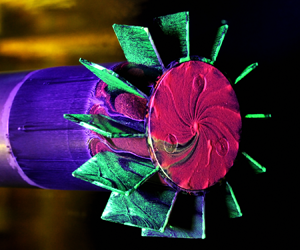Article contents
Influence of swirl on the supersonic wake flow structure behind blunt-based axisymmetric afterbodies
Published online by Cambridge University Press: 27 August 2021
Abstract

Wind-tunnel experiments have been conducted on cylindrical models with canted fins. The fins introduced a swirling motion into the wake downstream of a blunt-based afterbody aligned with a Mach 2 flow. Measurements of the velocity field downstream of the models and the pressure distribution at the model base show evidence of two wake flow patterns distinctively differing from the classical supersonic wake, depending on the degree of rotation introduced. For a fin-cant angle of 16 $^\circ$, a rotating wake flow with a central, downstream-directed vortex tube and a concentric, counter-rotating, toric vortex pair forms. A higher fin-cant angle of 32
$^\circ$, a rotating wake flow with a central, downstream-directed vortex tube and a concentric, counter-rotating, toric vortex pair forms. A higher fin-cant angle of 32 $^\circ$, in turn, results in a swirling flow surrounding a region of low-momentum flow at the axis. Near the central axis of the flow field an upstream flow establishes, extending from the far wake up to the model base. Numerical simulations have been performed to explain the fluid-dynamic processes and the origins of the experimentally observed structural changes of the rotating wakes. The results of the large-scale-turbulence-resolving simulations agree qualitatively well with the measured flow fields. The numerical results show that the centrifugal forces decrease the base pressure and cause the experimentally observed structural changes in the wake.
$^\circ$, in turn, results in a swirling flow surrounding a region of low-momentum flow at the axis. Near the central axis of the flow field an upstream flow establishes, extending from the far wake up to the model base. Numerical simulations have been performed to explain the fluid-dynamic processes and the origins of the experimentally observed structural changes of the rotating wakes. The results of the large-scale-turbulence-resolving simulations agree qualitatively well with the measured flow fields. The numerical results show that the centrifugal forces decrease the base pressure and cause the experimentally observed structural changes in the wake.
Information
- Type
- JFM Papers
- Information
- Copyright
- © French–German Research Institute of Saint-Louis, 2021. Published by Cambridge University Press
References
REFERENCES
Weidner et al. supplementary movie 1
\begin{figure} \caption{Video recording of the oil flow visualization for the afterbody model with \SI{0}{\degree}-canted fins.} \end{figure}
Weidner et al. supplementary movie 2
\begin{figure} \caption{Video recording of the oil flow visualization for the afterbody model with \SI{16}{\degree}-canted fins.} \end{figure}
Weidner et al. supplementary movie 3
\begin{figure} \caption{Video recording of the oil flow visualization for the afterbody model with \SI{32}{\degree}-canted fins.} \end{figure}
Weidner et al. supplementary movie 4
\begin{figure} \caption{Animation of the time-averaged streamtraces for the afterbody model with \SI{0}{\degree}-canted fins based on DES simulations.} \end{figure}
Weidner et al. supplementary movie 5
\begin{figure} \caption{Animation of the time-averaged streamtraces for the afterbody model with \SI{16}{\degree}-canted fins based on DES simulations.} \end{figure}
- 2
- Cited by


